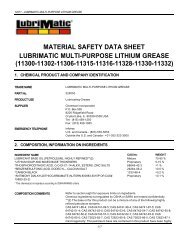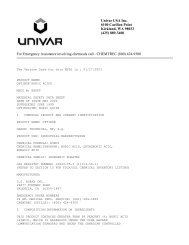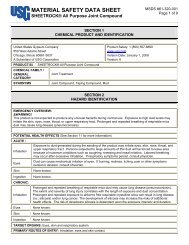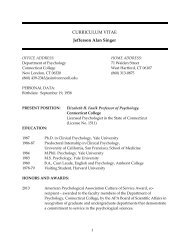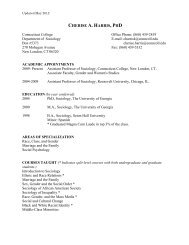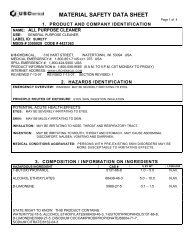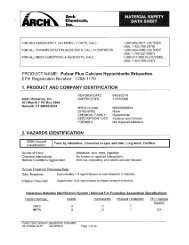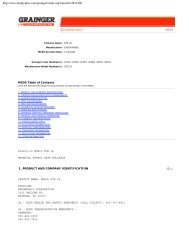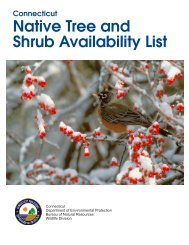Themed issue: Green fluorescent protein - Connecticut College
Themed issue: Green fluorescent protein - Connecticut College
Themed issue: Green fluorescent protein - Connecticut College
Create successful ePaper yourself
Turn your PDF publications into a flip-book with our unique Google optimized e-Paper software.
Chemical Society Reviews<br />
www.rsc.org/chemsocrev Volume 38 | Number 10 | October 2009 | Pages 2813–2968<br />
ISSN 0306-0012<br />
Guest editors: Jeremy Sanders and Sophie Jackson<br />
HIGHLIGHT<br />
Marc Zimmer<br />
GFP: from jelly�sh to the Nobel prize<br />
and beyond<br />
<strong>Themed</strong> <strong>issue</strong>: <strong>Green</strong> <strong>fluorescent</strong> <strong>protein</strong><br />
TUTORIAL REVIEW<br />
Wolf B. Frommer, Michael W. Davidson<br />
and Robert E. Campbell<br />
Genetically encoded biosensors based<br />
on engineered �uorescent <strong>protein</strong>s<br />
0306-0012(2009)38:10;1-Q
This article was published as part of the<br />
2009 <strong>Green</strong> Fluorescent Protein <strong>issue</strong><br />
Reviewing the latest developments in the science of green<br />
<strong>fluorescent</strong> <strong>protein</strong><br />
Guest Editors Dr Sophie Jackson and Professor Jeremy Sanders<br />
All authors contributed to this <strong>issue</strong> in honour of the 2008 Nobel Prize winners in<br />
Chemistry, Professors Osamu Shimomura, Martin Chalfie and Roger Y. Tsien<br />
Please take a look at the <strong>issue</strong> 10 table of contents to access<br />
the other reviews
HIGHLIGHT www.rsc.org/csr | Chemical Society Reviews<br />
GFP: from jellyfish to the Nobel prize<br />
and beyondw<br />
Marc Zimmer<br />
DOI: 10.1039/b904023d<br />
On December 10, 2008 Osamu Shimomura, Martin Chalfie and Roger Tsien were<br />
awarded the Nobel Prize in Chemistry for ‘‘the discovery and development of the green<br />
<strong>fluorescent</strong> <strong>protein</strong>, GFP’’. The path taken by this jellyfish <strong>protein</strong> to become one of the<br />
most useful tools in modern science and medicine is described. Osamu Shimomura<br />
painstakingly isolated GFP from hundreds of thousands of jellyfish, characterized the<br />
chromophore and elucidated the mechanism of Aequorean bioluminescence.<br />
Martin Chalfie expressed the <strong>protein</strong> in E. coli and C. elegans, and Roger Tsien developed<br />
a palette of <strong>fluorescent</strong> <strong>protein</strong>s that could be used in a myriad of applications.<br />
1. From jellyfish to the<br />
Nobel prize<br />
‘‘I decided to find out who the schnook<br />
was that won this year’s prize. So I<br />
opened up my laptop and found out I<br />
was the schnook.’’ That was how Marty<br />
Chalfie described his discovery that he<br />
had been awarded the Nobel Prize in<br />
Chemistry for 2008. He shared the award<br />
with Roger Tsien and Osamu Shimomura<br />
‘‘for the discovery and development of<br />
the green <strong>fluorescent</strong> <strong>protein</strong>, GFP.’’<br />
This year’s award is particularly interesting<br />
Chemistry Department, <strong>Connecticut</strong> <strong>College</strong>,<br />
New London, CT06320, USA.<br />
E-mail: mzim@conncoll.edu<br />
w Part of a themed <strong>issue</strong> on the topic of green<br />
<strong>fluorescent</strong> <strong>protein</strong> (GFP) in honour of the<br />
2008 Nobel Prize winners in Chemistry,<br />
Professors Osamu Shimomura, Martin Chalfie<br />
and Roger Y. Tsien.<br />
Marc Zimmer at the Nobel<br />
Award Ceremony<br />
as it recognizes the basic research that<br />
Osamu Shimomura did in order to<br />
understand the photophysics involved<br />
in Aequorean bioluminescence (a field<br />
of research that would probably not be<br />
funded under current funding criteria)<br />
and the work of Chalfie and Tsien that<br />
took an interesting but esoteric <strong>protein</strong><br />
and made it one of the most useful tools<br />
in modern biology and medicine. It is my<br />
hope that by the end of this highlight the<br />
reader will realize that Shimomura,<br />
Chalfie and Tsien are no schnooks and<br />
that the GFP Nobel award was richly<br />
deserved.<br />
In August 1960 Osamu Shimomura left<br />
Japan with a Fulbright Fellowship to<br />
work in the laboratory of Prof. Frank<br />
Johnson at Princeton University. His<br />
project was to elucidate the mechanism<br />
of bioluminescence of the jellyfish<br />
Aequorea aequorea (also known as<br />
Marc Zimmer uses computational methods to examine<br />
the chromophore formation and photophysics of<br />
<strong>fluorescent</strong> <strong>protein</strong>s. He has been a faculty<br />
member at <strong>Connecticut</strong> <strong>College</strong> since 1990. Douglas<br />
Prasher (see this highlight) and Bruce Branchini<br />
(a firefly luciferase chemist at <strong>Connecticut</strong> <strong>College</strong>)<br />
introduced him to GFP. Marc wrote Glowing Genes<br />
the first book to be published about GFP and is<br />
responsible for the upkeep of ‘‘The GFP Site’’ at<br />
http://gfp.conncoll.edu.<br />
Aequorea victoria). The jellyfish were<br />
found in the Northeastern Pacific so<br />
every summer from 1961 to the eighties<br />
Shimomura and his family would make<br />
the 5000 km drive from Princeton,<br />
New Jersey to the University of<br />
Washington’s Friday Harbor laboratory.<br />
Jellyfish were abundant and could be<br />
scooped up from a pier using large<br />
shallow nets. Each jellyfish has a couple<br />
hundred photoorgans located on the edge<br />
of its umbrella, when stimulated they give<br />
off green light, see Fig. 1.<br />
Prior to Shimomura’s jellyfish work,<br />
all known bioluminescent organisms,<br />
such as Cypridina hilgedorfii studied by<br />
Shimomura in Japan 2 and the firefly, 3<br />
used a luciferin/luciferase system to<br />
produce light. Shimomura and Johnson<br />
discovered that Aequorea victoria was<br />
different. Two <strong>protein</strong>s were involved in<br />
Aequorea bioluminescence—a calcium<br />
binding <strong>protein</strong> and a green <strong>fluorescent</strong><br />
<strong>protein</strong>. In their first summer at Friday<br />
Harbor Shimomura and Johnson caught<br />
over 10 000 jellyfish from which they<br />
isolated 1 mg of the luminescent calcium<br />
binding <strong>protein</strong> which they named<br />
aequorin. 4 In a 1962 paper devoted to<br />
the extraction, purification and properties<br />
of aequorin, 4 the <strong>fluorescent</strong> <strong>protein</strong> was<br />
described as ‘‘a <strong>protein</strong> giving solutions<br />
that look slightly greenish in sunlight<br />
though only yellowish under tungsten<br />
lights, and exhibiting a very bright,<br />
greenish fluorescence in the ultraviolet<br />
of a Mineralite.’’ The green fluorescence<br />
of the Aequorea light organs had been<br />
described before, 5 but this was the first<br />
This journal is c The Royal Society of Chemistry 2009 Chem. Soc. Rev., 2009, 38, 2823–2832 | 2823
Fig. 1 Aequorea victoria photo organs (left), the whole jellyfish in the dark (middle) and under<br />
visible light (right). (Photocredits: Steve Haddock and his bioluminescence web page, 1 Monterey<br />
Bay Aquarium Research Institute (left image). Osamu Shimomura (right and middle images)).<br />
time it was shown that the green<br />
substance responsible for the fluorescence<br />
was a <strong>protein</strong>.<br />
Over the next 20 years in order to<br />
isolate enough of the jellyfish <strong>protein</strong>s<br />
Shimomura caught hundreds of thousands<br />
of jellyfish. They were plentiful at Friday<br />
Harbor ‘‘a constant stream of floating<br />
jellyfish passed along the side of the lab<br />
dock every morning and evening, riding<br />
with the current caused by the tide.<br />
Sometimes they were extremely abundant,<br />
covering the surface of the water.’’ 6 Once<br />
caught Shimomura used a homemade<br />
jellyfish slicer to cut-off the part of the<br />
jellyfish umbrella that contained the<br />
photoorgans. When the rings of twenty<br />
to thirty jellyfish were squeezed through<br />
a rayon gauze, a faintly luminescent<br />
liquid called squeezate was obtained. In<br />
the squeezate aequorin gives off blue<br />
light upon binding calcium, however in<br />
the jellyfish radiationless (Fo¨ rster-type)<br />
energy transfer occurs and the <strong>fluorescent</strong><br />
<strong>protein</strong> absorbs the blue light emitted<br />
by aequorin (l max = 470 nm) and fluoresces<br />
green (l max = 509 nm). 7,8 Hence it<br />
was named green <strong>fluorescent</strong> <strong>protein</strong><br />
(GFP), 9 eqn (1).<br />
It was easier to isolate aequorin than<br />
GFP, therefore Shimomura concentrated<br />
most of his research effort on studying<br />
aequorin 6,10,11 and he thinks that his best<br />
work was done in this area, but it is his<br />
research on GFP, the <strong>protein</strong> associated<br />
with aequorin in Aequorea victoria, that<br />
garnered him the Nobel prize. By 1971<br />
Shimomura and his co-workers had<br />
collected enough GFP to start analyzing it.<br />
In 1974 he described the purification and<br />
crystallization of GFP, as well as the<br />
intermolecular energy transfer between<br />
aequorin and GFP in the jellyfish. This<br />
Fo¨ rster-type energy transfer also occurs<br />
when aequorin and GFP are co-absorbed<br />
on a Sephadex column, eqn (1). 8<br />
Aequorea GFP and the GFP found in<br />
the sea pansy Renilla 12 were the only<br />
<strong>fluorescent</strong> <strong>protein</strong>s known at the time.<br />
One of Shimomura’s most important<br />
contributions to the field was to determine<br />
the structure of the chromophore in<br />
GFP. He denatured GFP and digested<br />
it with papain. Only one of the fragments<br />
obtained absorbed above 300 nm and<br />
had a similar absorption spectrum to<br />
GFP. Although it did not fluoresce<br />
it was assumed that this was the<br />
chromophore. Acid hydrolysis, UV and<br />
mass spectroscopy as well as synthesis of<br />
model compounds were used to determine<br />
a structure for the chromophore<br />
shown in Fig. 2. 13 Since then the<br />
structure of the chromophore proposed<br />
by Shimomura has been confirmed. 14–16<br />
Shimomura’s research was basic<br />
research at its best. He spent more than<br />
twenty years elucidating the photophysics<br />
of Aequorea bioluminescence.<br />
Shimomura never foresaw the multitude<br />
of uses for GFP and although he was<br />
intrigued by the potential uses of aequorin<br />
as a calcium monitor that never drove his<br />
research. 17 In today’s funding climate it<br />
is unlikely that his research would have<br />
been funded. Fortunately he found<br />
funding and laid the foundation of the<br />
2008 Nobel Prize in Chemistry.<br />
ð1Þ<br />
During the late seventies Milt<br />
Cormier’s laboratory isolated and<br />
characterized the <strong>protein</strong>s involved in<br />
the bioluminescence observed in the sea<br />
pansy, Renilla. Therearemanysimilarities<br />
between Renilla and Aequorea, both have<br />
a green <strong>fluorescent</strong> <strong>protein</strong> that is excited<br />
by radiationless energy transfer from a<br />
neighboring blue luminescent <strong>protein</strong><br />
and both their GFPs have similar but<br />
not identical chromophores. 12 Therefore<br />
it is not surprising that the Cormier<br />
group examined the bioluminescence of<br />
both organisms. Isolation, purification<br />
and characterization of these <strong>protein</strong>s<br />
was painstaking work since thousands<br />
of animals were needed to obtain the<br />
few milligrams required to do the<br />
characterization. Advances in cloning<br />
promised to solve these problems. Bill<br />
Ward, a postdoc in Cormier’s lab, took<br />
the first step by sequencing Aequorea<br />
aequorin and GFP, then another<br />
postdoc in the lab, Doug Prasher, cloned<br />
Aequorea aequorin. 18 In Cormier’s lab<br />
Prasher also started to clone Aequorea<br />
GFP. He successfully cloned the GFP<br />
gene from the lab’s Aequorea cDNA<br />
library, but upon sequencing the gene<br />
found that it only represented 70% of<br />
the full-length gene. 19 At that time<br />
Prasher moved from the Cormier lab<br />
and got a position at Woods Hole<br />
Oceanographic Institute.<br />
In the Cormier group the main<br />
incentive for the cloning of aequorin<br />
and GFP was the production of larger<br />
amounts of the <strong>protein</strong>s, 19 but no one<br />
had considered using it as a genetically<br />
encoded fluorophore. While at Woods<br />
Hole, Douglas Prasher worked on using<br />
aequorin as a genetically incorporated<br />
calcium sensor and was the first to get<br />
the idea that GFP could be used in<br />
imaging. After collecting more jellyfish<br />
at Friday Harbor, Prasher sequenced<br />
and cloned GFP. 20 Fig. 3 lists the DNA<br />
Fig. 2 Structure of the chromophore of<br />
Aequorea GFP. 13<br />
2824 | Chem. Soc. Rev., 2009, 38, 2823–2832 This journal is c The Royal Society of Chemistry 2009
Fig. 3 Nucleotide and amino acid sequence of GFP cDNA as reported by Prasher. 20 The<br />
chromophore forming amino acids are bold and underlined. Additional nucleotides preceding<br />
and following the GFP gene in the Prasher vector are italicized.<br />
and <strong>protein</strong> sequence. The resultant<br />
cloned GFP was not <strong>fluorescent</strong> and<br />
Prasher concluded, ‘‘These results will<br />
enable us to construct an expression<br />
vector for the preparation of non<strong>fluorescent</strong><br />
apoGFP.’’ 20 This view that<br />
GFP would not be the genetically<br />
encoded fluorophore envisioned by<br />
Prasher when he started cloning GFP<br />
was reinforced in a follow-up paper on<br />
the structure of the chromophore in GFP<br />
in which Bill Ward wrote, ‘‘The posttranslational<br />
events required for chromophore<br />
formation are not yet understood.<br />
It is very unlikely that the chromophore<br />
forms spontaneously, but its formation<br />
probably requires enzymatic machinery.’’ 14<br />
Unable to find more funding for his<br />
GFP work and not confident that GFP<br />
would function as a tracer molecule<br />
Doug Prasher focused on his other<br />
research projects.<br />
Marty Chalfie’s road to the Nobel<br />
Chemistry Prize started in High School,<br />
where he was friends with Bob Horvitz.<br />
After an undergraduate degree with<br />
marginal chemistry grades, a year of high<br />
school chemistry teaching and a PhD in<br />
physiology from Harvard University in<br />
1972, it was the advice of the same Bob<br />
Horvitz that convinced Chalfie to do his<br />
postdoctoral studies in the laboratory of<br />
Sydney Brenner. There he worked on<br />
Caenorhabditis elegans with Brenner,<br />
Horvitz and Sulston, who would go on<br />
to be awarded the 2002 Nobel Prize in<br />
Medicine. C. elegans is see-through and<br />
so it was that Chalfie first had the idea of<br />
using <strong>fluorescent</strong> <strong>protein</strong>s to see when<br />
<strong>protein</strong> expression occurred in C. elegans.<br />
The idea came to him just a little after<br />
noon on Tuesday, April 25th, 1989. Paul<br />
Brehm, then at Tufts, was giving a noon<br />
seminar to the neurobiology groups at<br />
Columbia University. In the talk he<br />
described Shimomura’s work and the<br />
role of GFP in emission of green light<br />
by Aequorea victoria, eqn (1). At that<br />
point of the seminar Chalfie stopped<br />
paying attention and started dreaming<br />
about using the mechanosensor promoters<br />
he was studying in C. elegans to promote<br />
expression of the <strong>fluorescent</strong> GFP. After<br />
the talk he spent a few days trying to find<br />
out whether someone had cloned GFP.<br />
He heard about Prasher’s work and<br />
contacted him. They discovered they<br />
had similar ideas and agreed to collaborate<br />
once Prasher had succeeded in<br />
cloning the GFP cDNA.<br />
A few years later after having cloned<br />
(non-<strong>fluorescent</strong>) GFP Prasher tried<br />
contacting Chalfie, but was unsuccessful<br />
as Chalfie was on sabbatical at the<br />
University of Utah. That would have<br />
been the end of Chalfie’s involvement in<br />
the GFP story, however in September<br />
1992 Chalfie got a rotation student with<br />
fluorescence microscopy experience. The<br />
GFP idea popped up again as it would be<br />
a great rotation project, so he decided to<br />
see if Prasher had cloned GFP. Chalfie<br />
found the GFP cloning paper in Gene,<br />
called Prasher to re-establish the<br />
collaboration and 6 days later was sent<br />
the GFP gene. At this point Chalfie had<br />
two options, he could cut the GFP gene<br />
out of the vector sent by Prasher using<br />
the same restriction enzymes Prasher had<br />
used, giving him a GFP gene with some<br />
additional nucleotides before and after<br />
This journal is c The Royal Society of Chemistry 2009 Chem. Soc. Rev., 2009, 38, 2823–2832 | 2825
the GFP gene, see Fig. 3, or he could use<br />
PCR to amplify the GFP coding gene.<br />
Fortunately he chose the latter route for<br />
it was the DNA that preceded the GFP<br />
gene, Fig. 3, that prevent the correct<br />
folding of GFP and its subsequent<br />
autocatalytic chromophore formation. 21<br />
One month after receiving the GFP<br />
cDNA the rotation student, Ghia<br />
Euskirchen, succeeded in creating green<br />
<strong>fluorescent</strong> E. coli, see Fig. 4. There were<br />
two reasons she was successful. Firstly,<br />
she used only the GFP coding region,<br />
and secondly she had experience with<br />
and had access to fluorescence microscopes,<br />
which allowed her to distinguish<br />
between the inherent green autofluorescence<br />
of the bacteria and GFP fluorescence.<br />
This was a major breakthrough.<br />
GFP autocatalytically formed its own<br />
chromophore. It didn’t need any other<br />
enzymes to become <strong>fluorescent</strong>, which<br />
presumably meant that <strong>fluorescent</strong><br />
GFP could be expressed in all living<br />
organisms. Indeed Chalfie was soon able<br />
to use known promoters to express GFP<br />
in the touch neurons of C. elegans. 22<br />
Bill Ward, who had worked with<br />
Cormier and Prasher, joined the collaboration<br />
and showed that the absorption<br />
and emission properties of GFP were<br />
identical in E. coli and in the native<br />
jellyfish GFP. 22 Tulle Hazelrigg, who<br />
happens to be married to Martin Chalfie<br />
and is an excellent scientist independent<br />
of Chalfie, was responsible for the<br />
next important contribution to the<br />
GFP field. She made the first GFP<br />
fusion <strong>protein</strong> and proved that it could<br />
functionally replace the original <strong>protein</strong><br />
thereby showing where in the cell the<br />
<strong>protein</strong> resided. 23<br />
Douglas Prasher had two requests for<br />
his GFP gene, both Martin Chalfie and<br />
Fig. 4 Ghia Euskirchen’s lab notebook for October 13, 1992.<br />
Roger Tsien had conceived of using GFP<br />
as a genetically encoded tracer molecule.<br />
Tsien wanted to follow cAMP in live<br />
cells and also collaborated with Prasher.<br />
In fact Roger Tsien’s request for the gene<br />
preceded Chalfie’s request and he had the<br />
gene before Chalfie. However Roger<br />
Tsien’s lab was a chemistry lab and he<br />
didn’t have a molecular biologist who<br />
could work with GFP DNA. He had to<br />
wait for a post-doc with the appropriate<br />
experience to arrive in his lab before he<br />
could try using GFP as a fusion tag. By<br />
the time Roger Heim, the post-doc,<br />
arrived in the Tsien lab, Euskirchen and<br />
Chalfie had already expressed <strong>fluorescent</strong><br />
GFP in E. coli. This did not deter Tsien<br />
who has largely been responsible for<br />
maturing the <strong>fluorescent</strong> <strong>protein</strong> (FP)<br />
field and for developing a palette of user<br />
friendly FPs.<br />
In the same year that Chalfie<br />
reported 22 the expression of GFP in<br />
E. coli and C. elegans Tsien reported that<br />
the autocatalytic chromophore formation<br />
in GFP was oxygen dependent and<br />
proposed the biosynthetic pathway for<br />
chromophore formation shown in<br />
Fig. 5. 24 He also described the creation<br />
of the first wavelength mutation of GFP<br />
and proposed the possibility of utilizing<br />
fluorescence energy transfer (FRET)<br />
measurements between GFP and its<br />
mutants, such as the newly created blue<br />
<strong>fluorescent</strong> <strong>protein</strong> (BFP = a Y66H<br />
GFP mutant). 24<br />
Wild-type GFP has some deficiencies;<br />
one of them being the fact that it has two<br />
excitation peaks due to the neutral and<br />
anionic forms of the chromophore<br />
shown in Fig. 5. Tsien found that the<br />
S65T GFP mutant has only one excitation<br />
peak, a six-fold increased brightness<br />
and a four-fold increase in the rate of<br />
oxidation of chromophore. It is the basis<br />
of the most commonly used FP, enhanced<br />
green <strong>fluorescent</strong> <strong>protein</strong> (EGFP). 26,27<br />
Diffraction quality crystals of GFP<br />
were grown by Ward 28 long before it<br />
was used as a <strong>fluorescent</strong> tracer molecule,<br />
but it was only in 1996 that the crystal<br />
structure of GFP was solved and then it<br />
was solved simultaneously by the<br />
Phillips 16 (wild-type GFP) and Tsien/<br />
Remington 15 (enhanced GFP) groups.<br />
GFP has an 11-stranded b-barrel with<br />
an a-helix running through the b-barrel.<br />
The chromophore is located in the center<br />
of the barrel and is protected from bulk<br />
2826 | Chem. Soc. Rev., 2009, 38, 2823–2832 This journal is c The Royal Society of Chemistry 2009
Fig. 5 Proposed scheme for the formation of the GFP chromophore. The upper two forms of<br />
GFP are non-<strong>fluorescent</strong>. Oxidation of Tyr66 is required to form two <strong>fluorescent</strong> states. The<br />
neutral form is excited at 395 nm while the anionic form is excited at 475 nm. 24,25<br />
Fig. 6 Crystal structure of GFP. The chromophore<br />
is shown in green and is located in the<br />
center of the b-barrel. Coordinates obtained<br />
from the PDB (1GFL).<br />
solvent, see Fig. 6. The barrel has a diameter<br />
of about 24 A˚ and a height of 42 A˚ .<br />
The crystal structures revealed several<br />
polar residues and water molecules that<br />
comprise a hydrogen bonding network<br />
around the chromophore. Fig. 7 shows<br />
all the short-range interactions between<br />
the chromophore and the surrounding<br />
<strong>protein</strong> in S65T GFP. 15<br />
In the first rationally designed mutant<br />
based on the crystal structure of<br />
GFP-S65T Tsien and co-workers<br />
decided to mutate T203 into a tyrosine<br />
so that it could p stack with the phenolic<br />
group in the chromophore. 15 The<br />
resultant yellow <strong>fluorescent</strong> <strong>protein</strong>,<br />
YFP, is red-shifted by 16 nm relative to<br />
GFP-S65T and does indeed have a p<br />
stacking interaction between the<br />
chromophore and Tyr203. 29<br />
The green, blue, cyan and yellow<br />
<strong>fluorescent</strong> <strong>protein</strong>s developed by the late<br />
90’s were the start of a color palette of<br />
FPs but a very important color, red, was<br />
still missing. A large search for red FPs<br />
was initiated. Groups all over the world<br />
tried mutating GFP to form a red GFP<br />
mutant. This strategy was not very<br />
successful and we would have to wait<br />
until 2008 before a red mutant of<br />
Aequorea victoria GFP was created. 30<br />
Other groups took to oceans to look<br />
for red bioluminescent organisms. They<br />
were no more successful. It took a<br />
conceptual shift to find red <strong>fluorescent</strong><br />
<strong>protein</strong>s. Lukyanov and Labas made the<br />
breakthrough. 31 Thinking that aequorin<br />
and GFP might have evolved separately<br />
and that <strong>fluorescent</strong> <strong>protein</strong>s did not<br />
necessarily have to be associated with<br />
other chemiluminescent <strong>protein</strong>s, they<br />
decided to look for organisms that<br />
were red <strong>fluorescent</strong> but were not bioluminescent.<br />
In aquarium shops in Moscow<br />
they found corals containing the first<br />
‘‘red’’ <strong>fluorescent</strong> <strong>protein</strong>, DsRed. Since<br />
Lukyanov found DsRed in 1999, over<br />
150 distinct <strong>fluorescent</strong> or colored<br />
GFP-like <strong>protein</strong>s have been reported.<br />
In fact the majority of GFP containing<br />
organisms are non-bioluminescent. 32<br />
These FPs can be divided into seven<br />
groups according to their color and<br />
chromophore structure, 33 see Fig. 8.<br />
DsRed was not ideal for imaging<br />
work, it is more orange than red, tetrameric,<br />
slow to mature and goes through<br />
an intermediate green state before the red<br />
<strong>fluorescent</strong> form is obtained. Using mass<br />
spectroscopy, theoretical calculations<br />
and other methods, Tsien showed that<br />
the DsRed chromophore was formed<br />
by an additional oxidation which<br />
extended the conjugation of the GFP<br />
chromophore as shown in Fig. 8C. 34<br />
The red chromophore structure was<br />
later confirmed by two crystal<br />
structures. 35,36<br />
Fig. 7 Schematic diagram of the interactions between the chromophore and its surroundings in<br />
the S65T mutant. 15 Possible hydrogen bonds are drawn as dashed lines.<br />
This journal is c The Royal Society of Chemistry 2009 Chem. Soc. Rev., 2009, 38, 2823–2832 | 2827
Fig. 8 Chemical diversity of chromophores generated in GFP-like <strong>protein</strong>s.<br />
It would take 33 mutations to DsRed to<br />
create the first monomeric red FP<br />
(mRFP1). 37 However the Tsien group was<br />
not happy with mRFP1 as it photobleaches<br />
quickly and has a significantly reduced<br />
fluorescence, they therefore continued to<br />
search for more FPs. In 2004 Tsien introduced<br />
the mFruits; 38,39 apaletteofFPswas<br />
rapidly being created, see Fig. 9.<br />
A number of groups have randomly<br />
mutated <strong>fluorescent</strong> <strong>protein</strong>s and screened<br />
for brightness or specific wavelengths.<br />
Fig. 9 mFruit FPs derived from mRFP1 39 and by somatic hypermutation (SHM). 38 E stands<br />
for enhanced versions of GFP, m are monomeric <strong>protein</strong>s and tdTomato is a head-to-tail dimer.<br />
(Image from Roger Y. Tsien Nobel Lecture 8 December 2008).<br />
In a fairly recent Nature Methods<br />
article Tsien et al. describe how they<br />
improved the photostability of bright<br />
monomeric orange and red <strong>fluorescent</strong><br />
<strong>protein</strong>s by screening for enhanced<br />
photostability. 40<br />
Initially it was Tsien’s desire to create<br />
a <strong>fluorescent</strong> sensor for cAMP that got<br />
him involved in <strong>fluorescent</strong> <strong>protein</strong><br />
research. It is therefore not surprising<br />
that over the past 10 years Tsien has also<br />
created a number of genetically encoded<br />
FRET sensors, 41 such as a calcium, 42,43<br />
protease, 44 phosphorylation 45 and of<br />
course a cAMP sensor. 46,47<br />
2. Beyond<br />
A literature search for papers with<br />
‘‘green <strong>fluorescent</strong> <strong>protein</strong>’’ in the title,<br />
abstract or keywords found one paper<br />
published in 1990, 1441 in 1999 and 4210<br />
in 2008.z Two books for the non-scientist<br />
have been written about GFP, 17,48<br />
<strong>fluorescent</strong> <strong>protein</strong>s have appeared in<br />
numerous art exhibits, and a Google<br />
search reveals more than 150 000 GFP<br />
images. There is clearly a lot of interesting<br />
and important GFP research that is<br />
beyond the direct jellyfish ) Osamu<br />
Shimomura ) Martin Chalfie )<br />
Roger Tsien ) Nobel Prize linage.<br />
Many of the most important developments<br />
will be highlighted in other reviews<br />
in this <strong>issue</strong> of Chemical Society Reviews.<br />
I will use Fig. 10 to introduce some GFP<br />
research that is beyond the work that<br />
was rewarded in 2008’s Nobel Chemistry<br />
Prize and to discuss some future<br />
directions <strong>fluorescent</strong> <strong>protein</strong> research<br />
might take.<br />
2.1 Spectral diversity and<br />
quantum yield<br />
The beach scene in Fig. 10 shows some of<br />
the mFruit colors available since<br />
2004. 38,39 There is a continuous effort<br />
to find new and brighter colored FPs.<br />
The spectral diversity of the <strong>fluorescent</strong><br />
<strong>protein</strong>s is obtained by slight variations<br />
in the structure of the imidazolinonebased-chromophore<br />
(see Fig. 8) and the<br />
interactions of these chromophores with<br />
the <strong>protein</strong> environment. The different<br />
chromophores are responsible for coarse<br />
z Basic Scopus (Elsevier B.V.) search for<br />
‘‘green <strong>fluorescent</strong> <strong>protein</strong>’’ in article title,<br />
abstract and keywords in all subject areas.<br />
2828 | Chem. Soc. Rev., 2009, 38, 2823–2832 This journal is c The Royal Society of Chemistry 2009
Fig. 10 Clockwise from top left corner. Agar plate of bacterial colonies expressing mFruit <strong>fluorescent</strong> <strong>protein</strong>s (R. Tsien). To celebrate the 125th<br />
birthday of Albert Einstein, a photograph of the scientist was covered with a EosFP tagged polymer coating, which was excited to produce a green<br />
<strong>fluorescent</strong> Einstein and then photoconverted to the red <strong>fluorescent</strong> version (J. Wiedenmann). The X-ray structure of IrisFP colored green and red,<br />
surrounded by photographs of IrisFP crystals in its different forms (switched on/off, green/red), recorded in the fluorescence mode (V. Adam).<br />
Visual appearance of bacteria expressing mutant <strong>protein</strong>s that retrace the green to red transition within the phylogenetic tree of colors from<br />
corals of the family Faviida (M. Matz). Brainbow confocal image of cerebral cortex (Confocal image by Tamily Weissman. Mouse by Jean Livet and<br />
Ryan Draft). Fucci (<strong>fluorescent</strong>, ubiquitination-based cell cycle indicator) modified cells are yellow at the start of replication, switch to green during<br />
S phase and to red during G1. Here they are used to visualize cell cycle progression in mouse eye development (A. Miyawaki).<br />
spectral adjustments, while the fine<br />
wavelength shifts are accomplished by<br />
changing amino acids adjacent to the<br />
chromophore. A number of groups are<br />
trying to generate <strong>fluorescent</strong> <strong>protein</strong>s<br />
with new colors by using structural<br />
insights into spectral tuning. The field<br />
has recently been reviewed by Martynov. 49<br />
Several computational groups have also<br />
been examining FPs with an aim of<br />
understanding their spectral properties<br />
and quantum yields. 50–56<br />
There is a need for FPs that fluoresce<br />
in the far red and infra-red range,<br />
therefore existing FPs are continually<br />
being mutated and new red FPs, such<br />
as mKate, 57,58 mRuby 59 and R10-3, 60 are<br />
being created. The brightness of the<br />
<strong>fluorescent</strong> <strong>protein</strong>s is related to the<br />
amount of conformational freedom<br />
available to the chromophore within<br />
the <strong>protein</strong> matrix. 61–64 This knowledge<br />
has been used to create brighter DsRed<br />
mutants. 65<br />
The palette of mutated FPs is also<br />
continually enhanced by the addition of<br />
new FPs found in nature. The majority<br />
of these FPs have been found in<br />
corals, 32,66,67 however FPs have also<br />
been found in copepods 68 and even in<br />
amphioxus (lower chordates that look<br />
like eyeless fishes). 69<br />
2.2 Optical highlighters<br />
‘‘Facing the Light’’ was first displayed<br />
at the ‘‘125 years of Albert Einstein’’<br />
exhibition of the University of Ulm,<br />
which commemorated the 125th birthday<br />
of Albert Einstein. Jo¨ rg Wiedenmann<br />
and Franz Oswald created the images<br />
by taking a black and white image of<br />
Albert Einstein (top left Einstein in<br />
Fig. 10) covering it with a nitrocellulose<br />
membrane that had EosFP immobilized<br />
on it (top right Einstein). EosFP, named<br />
after the goddess of dawn, is a photoconvertible<br />
<strong>fluorescent</strong> <strong>protein</strong>. Initially<br />
it is green <strong>fluorescent</strong> (bottom left<br />
Einstein) but irradiation with UV light<br />
(390 30 nm) induces cleavage between<br />
the amide nitrogen and the a-carbon<br />
atom in the histidine adjacent to the<br />
chromophore resulting in a red <strong>fluorescent</strong><br />
form (bottom right Einstein).<br />
EosFP is an excellent example of a<br />
group of FPs that have been found and<br />
created that change their emission upon<br />
irradiation. They are known as optical<br />
highlighters. For convenience they<br />
have been classified into three groups:<br />
photoactivatable, photoconvertible and<br />
photoswitchable FPs. 70<br />
Photoactivatable FPs are dark and are<br />
irreversibly activated by irradiation. For<br />
example irradiation of PA-GFP 71 with<br />
intense violet light results in a 100-fold<br />
increase in green fluorescence. It is<br />
presumed that the violet light causes the<br />
decarboxylation of Glu222, which aids in<br />
the formation of the anionic <strong>fluorescent</strong><br />
form of the chromophore, see Fig. 11A.<br />
This journal is c The Royal Society of Chemistry 2009 Chem. Soc. Rev., 2009, 38, 2823–2832 | 2829
Fig. 11 Photoactivatable (A), photoconvertible (B) and photoswitchable (C) highlighter<br />
<strong>protein</strong>s. See text for more detailed description.<br />
Photoconvertible FPs such as<br />
EosFP, 72 Kaede, 73 and Dendra2 74 can<br />
be irreversibly converted from a green<br />
<strong>fluorescent</strong> form to a red <strong>fluorescent</strong><br />
form by violet or ultraviolet irradiation.<br />
The photoconversion is presumably<br />
associated with a cleavage occurring<br />
between the amide nitrogen and the<br />
alpha carbon of His62 that is followed<br />
by oxidation of the His62 sidechain, see<br />
Fig. 11B.<br />
Finally there are photoswitchable FPs<br />
which are dark and are reversibly<br />
activated by irradiation. It is presumed<br />
that photoswitchable FPs such as<br />
Dronpa, 75,76 mTFP0.7 77 and KFP 33,78<br />
switch between the dark E (or trans) state<br />
and the <strong>fluorescent</strong> Z (or cis) state, see<br />
Fig. 11C.<br />
Optical highlighters are sure to be an<br />
area of much research in the post GFP<br />
Nobel prize era. The driving force in this<br />
area is the need for more genetically<br />
encoded photoactivatable and photoswitchable<br />
<strong>fluorescent</strong> <strong>protein</strong>s that can<br />
be used in the newly developed superresolution<br />
microscopy techniques—<br />
FPALM (fluorescence photoactivated<br />
localization microscopy), 79<br />
PALM<br />
(photoactivatedlocalizationmicroscopy), 80<br />
iPALM (interferometric photoactivated<br />
localization microscopy) 81 and STORM<br />
(stochastic optical reconstruction<br />
microscopy). 82 In late 2008 a mutant of<br />
the photoconvertible EosFP was reported.<br />
‘‘Like its parent <strong>protein</strong> EosFP, IrisFP<br />
also photoconverts irreversibly to a redemitting<br />
state under violet light because<br />
of an extension of the conjugated pi-cloud<br />
of the chromophore, accompanied by a<br />
cleavage of the polypeptide back-bone.<br />
The red form of IrisFP exhibits a second<br />
reversible photo-switching process, which<br />
may also involve cis–trans isomerization<br />
of the chromophore.’’ 83 More recently<br />
another EosFP mutant, mEos2, was<br />
reported, which has a much lower aggregation<br />
tendency than EosFP. 84 In the same<br />
<strong>issue</strong> of Nature Methods aseriesofphotoactivatable<br />
mCherry mutants, named<br />
PAmCherry <strong>protein</strong>s, were reported. 85<br />
2.3 Evolution and function<br />
More than 15 000 papers have been<br />
published that use <strong>fluorescent</strong> <strong>protein</strong>s<br />
or have studied them, and yet we do<br />
not know the function of the <strong>fluorescent</strong><br />
<strong>protein</strong>s. Understanding the evolution of<br />
<strong>fluorescent</strong> <strong>protein</strong>s may one day lead to<br />
more knowledge about its function. Did<br />
the original FP ancestors have a function<br />
that had nothing to do with fluorescence?<br />
Quiet possibly since a number of<br />
GFP-like <strong>protein</strong>s are non-<strong>fluorescent</strong><br />
chromo<strong>protein</strong>s. Mostinterestingamongst<br />
these non-<strong>fluorescent</strong> <strong>protein</strong>s is<br />
nidogen, a <strong>protein</strong> found in basement<br />
membranes of animals, including<br />
humans. Although it does not contain a<br />
central chromophore, the overlap<br />
between the G2 nidogen domain and<br />
GFP barrels is extremely close (rms<br />
deviation of 2.5 A˚ for a superimposition<br />
of all 195 Ca atoms). 86<br />
An evolutionary analysis has shown<br />
that GFP and nidogen belong to the<br />
same superfamily; 68<br />
its function is<br />
unknown. Parsimony analysis 68 and<br />
ancestral reconstruction experiments 32,87<br />
suggest that all but one of the non-green<br />
colors arose from an ancestor with a<br />
canonical green chromophore. The<br />
exception is the yellow <strong>protein</strong> from<br />
Zoanthus sp., which is likely to have<br />
evolved from a DsRed-like red ancestor. 32<br />
The phylogeny provides an excellent<br />
scaffold for identifying the key colorconverting<br />
sequence changes. The<br />
bottom right image in Fig. 10 shows the<br />
visual appearance of bacteria expressing<br />
mutant <strong>protein</strong>s that retrace the greento-red<br />
transition from the ancestral green<br />
<strong>protein</strong> to the least evolved red ancestor<br />
within the coral family Faviida. A minimum<br />
of 12 mutations are required to fully<br />
recapitulate the present-day red fluorescence<br />
from the ancestral green <strong>protein</strong>.<br />
2.4 Applications<br />
The 2008 Nobel Prize in Chemistry was<br />
awarded to Shimomura, Chalfie and Tsien<br />
for their GFP research because GFP has<br />
developed into a tremendously useful<br />
molecule with applications in many areas<br />
of science and medicine. Therefore a<br />
highlight of this type should at least<br />
mention some GFP applications. Unfortunately<br />
it is impossible to review all the<br />
applications of <strong>fluorescent</strong> <strong>protein</strong>s, I will<br />
just mention two of my favorites.<br />
Never before have brains been as<br />
beautiful as those shown in the bottom<br />
center image in Fig. 10. They belong to<br />
2830 | Chem. Soc. Rev., 2009, 38, 2823–2832 This journal is c The Royal Society of Chemistry 2009
transgenic mice with <strong>fluorescent</strong> multicolored<br />
neurons created by a genetic<br />
strategy that randomly mixes green,<br />
cyan and yellow <strong>fluorescent</strong> <strong>protein</strong>s in<br />
individual neurons, thereby creating a<br />
palette of ninety distinctive hues and<br />
colors. 88 Using a brainbow of colors,<br />
researchers will now be able to map the<br />
neural circuits of the brain.<br />
Cell growth occurs through an ordered<br />
sequence of events—the cell cycle, which<br />
consists of four distinct phases, G1, S,<br />
G2 and M phase. Fucci (<strong>fluorescent</strong>,<br />
ubiquitination-based cell cycle indicator)<br />
allows cell cycle researchers to visualize<br />
cell cycle progression. 89 The Fucci<br />
modified cells are yellow at the start of<br />
replication, switch to green during S<br />
phase and to red during G1. To demonstrate<br />
the utility of Fucci, a Fucci mouse<br />
was created. The bottom left image in<br />
Fig. 10 shows the equilibrium between<br />
cell differentiation and cell proliferation<br />
that occurs during the development of a<br />
mouse eye.<br />
Hopefully these two examples demonstrate<br />
some of the utility, beauty and<br />
versatility of <strong>fluorescent</strong> <strong>protein</strong>-basedtechniques,<br />
and give the reader a hint<br />
that the development and the associated<br />
chemical understanding of FPs has<br />
just begun.<br />
3. Conclusion<br />
The 2008 Nobel Prize in Chemistry<br />
rewards both basic research as well as<br />
applied research. While Shimomura’s<br />
primary interest in GFP was its role in<br />
Aequorea bioluminescence, Tsien was<br />
interested in its practical applications.<br />
Hence he has developed brighter, faster<br />
maturing, more photostable <strong>fluorescent</strong><br />
<strong>protein</strong>s covering a spectrum of colors<br />
and has incorporated them into in vivo<br />
sensors. I hope that this award will<br />
remind those in charge of funding<br />
research that basic research can open<br />
the doors to very useful and often<br />
unexpected discoveries. On the other<br />
hand I hope that the award will also<br />
silence the purists who do not value<br />
applied research. Roger Tsien should<br />
not have to finish his Nobel speech with<br />
the following justification: ‘‘Some people<br />
have at times criticized us for mainly<br />
working on techniques. I would like to<br />
draw their attention to an old Chinese<br />
proverb that says that if you give a man a<br />
fish you feed him for one day, if you<br />
teach him how to fish you feed him for a<br />
lifetime. That’s why we enjoy devising<br />
fishing tackle and nets to scoop from the<br />
ocean of knowledge.’’<br />
Acknowledgements<br />
MZ is a Henry Dreyfus Teacher-Scholar<br />
and the Barbara Zaccheo Kohn<br />
‘72 Professor of Chemistry. His GFP<br />
research was funded by the NIH<br />
(Area Grant # R15 GM59108).<br />
References<br />
1 S. H. D. Haddock, C. M. McDougall and<br />
J. F. Case, ‘‘The Bioluminescence Web Page’’,<br />
http://lifesci.ucsb.edu/Bbiolum/.<br />
2 Y. Haneda, H. Sie, Y. Masuda,<br />
I. Takatsuki, N. Sugiyama, Y. Saiga,<br />
F. H. Johnson and O. Shimomura,<br />
J. Cell. Comp. Physiol., 1961, 57, 55–62.<br />
3 A. A. <strong>Green</strong> and W. D. McElroy, Biochim.<br />
Biophys. Acta, 1956, 20, 170–176.<br />
4 O. Shimomura, F. H. Johnson and<br />
Y. Saiga, J. Cell. Comp. Physiol., 1962,<br />
59, 223–229.<br />
5 D. Davenport and J. A. C. Nicol, Proc. R.<br />
Soc. London, Ser. B, 1955, 144, 399–411.<br />
6 O. Shimomura, J. Microsc. (Oxford),<br />
2005, 217, 3–15.<br />
7 J. G. Morin and J. W. Hastings, J. Cell.<br />
Physiol., 1971, 77, 313–318.<br />
8 H. Morise, O. Shimomura, F. H. Johnson<br />
and J. Winant, Biochemistry, 1974, 13,<br />
2656–2662.<br />
9 J. W. Hastings and J. G. Morin, Biol.<br />
Bull., 1969, 137, 402.<br />
10 O. Shimomura, Biol. Bull., 1995, 189, 1–5.<br />
11 J. F. Head, S. Inouye, K. Teranishi and<br />
O. Shimomura, Nature, 2000, 405,<br />
372–376.<br />
12 W. W. Ward, C. W. Cody, R. C. Hart and<br />
M. J. Cormier, Photochem. Photobiol.,<br />
1980, 31, 611–615.<br />
13 O. Shimomura, FEBS Lett., 1979, 104,<br />
220–222.<br />
14 C. W. Cody, D. C. Prasher,<br />
W. M. Westler, F. G. Prendergast and<br />
W. W. Ward, Biochemistry, 1993, 32,<br />
1212–1218.<br />
15 M. Ormoe, A. B. Cubitt, K. Kallio,<br />
L. A. Gross, R. Y. Tsien and<br />
S. J. Remington, Science, 1996, 273,<br />
1392–1395.<br />
16 F. Yang, L. G. Moss and G. N. Phillips,<br />
Nat. Biotechnol., 1996, 14, 1246–1251.<br />
17 M. Zimmer, Glowing Genes: A Revolution<br />
in Biotechnology, Prometheus Books,<br />
Amherst, N.Y., 2005.<br />
18 D. Prasher, R. O. McCann and<br />
M. J. Cormier, Biochem. Biophys. Res.<br />
Commun., 1985, 126, 1259–1268.<br />
19 M. Cormier, ASP News, 2008, 39, 4–5.<br />
20 D. C. Prasher, V. K. Eckenrode,<br />
W. W. Ward, F. G. Prendergast and<br />
M. J. Cormier, Gene, 1992, 111, 229–233.<br />
21 M. Zimmer, in The Providence<br />
Journal, 2008, http://www.projo.com/opinion/<br />
contributors/content/CT_zimmer22_10-22-<br />
08_EPBUEM2_v10.3e26e8e.html.<br />
22 M. Chalfie, Y. Tu, G. Euskirchen,<br />
W. W. Ward and D. C. Prasher, Science,<br />
1994, 263, 802–805.<br />
23 S. X. Wang and T. Hazelrigg, Nature,<br />
1994, 369, 400–403.<br />
24 R. Heim, D. C. Prasher and R. Y. Tsien,<br />
Proc. Natl. Acad. Sci. U. S. A., 1994, 91,<br />
12501–12504.<br />
25 K. Brejc, T. K. Sixma, P. A. Kitts,<br />
S. R. Kain, R. Y. Tsien, M. Ormo and<br />
S. J. Remington, Proc. Natl. Acad. Sci.<br />
U. S. A., 1997, 94, 2306–2311.<br />
26 R. Heim, A. Cubitt and R. Y. Tsien,<br />
Nature, 1995, 373, 663–664.<br />
27 A. B. Cubitt, R. Heim, S. R. Adams,<br />
A. E. Boyd, L. A. Gross and<br />
R. Y. Tsien, Trends Biochem. Sci., 1995,<br />
20, 448–455.<br />
28 M. A. Perozzo, K. B. Ward,<br />
R. B. Thompson and W. W. Ward,<br />
J. Biol. Chem., 1988, 263, 7713–7716.<br />
29 R. M. Wachter, M. A. Elsiger, K. Kallio,<br />
G. T. Hanson and S. J. Remington,<br />
Structure, 1998, 6, 1267–1277.<br />
30 A. S. Mishin, F. V. Subach, I. V. Yampolsky,<br />
W. King, K. A. Lukyanov and<br />
V. V. Verkhusha, Biochemistry, 2008, 47,<br />
4666–4673.<br />
31 M. V. Matz, A. F. Fradkov, Y. A. Labas,<br />
A. P. Savitisky, A. G. Zaraisky,<br />
M. L. Markelov and S. A. Lukyanov,<br />
Nat. Biotechnol., 1999, 17, 969–973.<br />
32 N. O. Alieva, K. A. Konzen, S. F. Field,<br />
E. A. Meleshkevitch, M. E. Hunt,<br />
V. Beltran-Ramirez, D. J. Miller,<br />
J. Wiedenmann, A. Salih and<br />
M. V. Matz, PLoS ONE, 2008, 3, e2680.<br />
33 Y. A. Labas, N. G. Gurskaya,<br />
Y. G. Yanushevich, A. F. Fradkov,<br />
K. A. Lukyanov, S. A. Lukyanov and<br />
M. V. Matz, Proc. Natl. Acad. Sci.<br />
U. S. A., 2002, 99, 4256–4261.<br />
34 L. A. Gross, G. S. Baird, R. C. Hoffman,<br />
K. K. Baldridge and R. Y. Tsien,<br />
Proc. Natl. Acad. Sci. U. S. A., 2000, 97,<br />
11990–11995.<br />
35 M. A. Wall, M. Socolich and<br />
R. Ranganathan, Nat. Struct. Biol., 2000,<br />
7, 1133–1138.<br />
36 D. Yarbrough, R. M. Wachter, K. Kallio,<br />
M. V. Matz and S. J. Remington,<br />
Proc. Natl. Acad. Sci. U. S. A., 2001, 98,<br />
462–467.<br />
37 R. E. Campbell, O. Tour, A. E. Palmer,<br />
P. A. Steinbach, G. S. Baird,<br />
D. A. Zacharias and R. Y. Tsien, Proc.<br />
Natl. Acad. Sci. U. S. A., 2002, 99,<br />
7877–7882.<br />
38 L. Wang, W. C. Jackson, P. A. Steinbach<br />
and R. Y. Tsien, Proc. Natl. Acad. Sci.<br />
U. S. A., 2004, 101, 16745–16749.<br />
39 N. C. Shaner, R. E. Campbell,<br />
P. A. Steinbach, B. N. G. Giepmans,<br />
A. E. Palmer and R. Y. Tsien, Nat.<br />
Biotechnol., 2004, 22, 1567–1572.<br />
40 N. C. Shaner, M. Z. Lin,<br />
M. R. McKeown, P. A. Steinbach,<br />
K. L. Hazelwood, M. W. Davidson and<br />
R. Y. Tsien, Nat. Methods, 2008, 5,<br />
545–551.<br />
41 J. Zhang, R. E. Campbell, A. Y. Ting and<br />
R. Y. Tsien, Nat. Rev. Mol. Cell Biol.,<br />
2002, 3, 906–918.<br />
This journal is c The Royal Society of Chemistry 2009 Chem. Soc. Rev., 2009, 38, 2823–2832 | 2831
42 A. Miyawaki, J. Llopis, R. Heim,<br />
J. M. McCaffrey, J. A. Adams, M. Ikura<br />
and R. Y. Tsien, Nature, 1997, 388,<br />
882–887.<br />
43 M. T. Hasan, R. W. Friedrich, T. Euler,<br />
M. E. Larkum, G. Giese, M. Both,<br />
J. Duebel, J. Waters, H. Bujard,<br />
O. Griesbeck, R. Y. Tsien, T. Nagai,<br />
A. Miyawaki and W. Denk, PLoS Biol.,<br />
2004, 2, e163.<br />
44 R. Y. Tsien, R. Heim and A. Cubitt,<br />
US Pat., US5981200-A, 1999.<br />
45 A. Y. Ting, K. H. Kain, R. L. Klemke and<br />
R. Y. Tsien, Proc. Natl. Acad. Sci.<br />
U. S. A., 2001, 98, 15003–15008.<br />
46 M. Zaccolo, F. De Giorgi, C. Y. Cho,<br />
L. X. Feng, T. Knapp, P. A. Negulescu,<br />
S. S. Taylor, R. Y. Tsien and T. Pozzan,<br />
Nat. Cell Biol., 2000, 2, 25–29.<br />
47 T. A. Dunn, C. T. Wang, M. A. Colicos,<br />
M. Zaccolo, L. M. DiPilato, J. Zhang,<br />
R. Y. Tsien and M. B. Feller,<br />
J. Neurosci., 2006, 26, 12807–12815.<br />
48 V. A. Pieribone and D. F. Gruber, Aglow<br />
in the Dark: The Revolutionary Science of<br />
Biofluorescence, Belknap Press of Harvard<br />
University Cambridge, Massachusetts, 2005.<br />
49 A. A. Pakhomov and V. I. Martynov,<br />
Chem. Biol., 2008, 15, 755–764.<br />
50 J. Y. Hasegawa, K. Fujimoto, B. Swerts,<br />
T. Miyahara and H. Nakatsuji, J. Comput.<br />
Chem., 2007, 28, 2443–2452.<br />
51 X. Lopez, M. A. L. Marques, A. Castro<br />
and A. Rubio, J. Am. Chem. Soc., 2005,<br />
127, 12329–12337.<br />
52 A. Sinicropi, T. Andruniow, N. Ferre,<br />
R. Basosi and M. Olivucci, J. Am. Chem.<br />
Soc., 2005, 127, 11534–11535.<br />
53 N. Taguchi, Y. Mochizuki, T. Nakano,<br />
S. Amari, K. Fukuzawa, T. Ishikawa,<br />
M. Sakurai and S. Tanaka, J. Phys. Chem.<br />
B, 2009, 113, 1153–1161.<br />
54 S. Olsen and S. C. Smith, J. Am. Chem.<br />
Soc., 2007, 129, 2054–2065.<br />
55 S. Olsen and S. C. Smith, J. Am. Chem.<br />
Soc., 2008, 130, 8677–8689.<br />
56 V. Voliani, R. Bizzarri, R. Nifosi,<br />
S. Abbruzzetti, E. Grandi, C. Viappiani<br />
and F. Beltram, J. Phys. Chem. B, 2008,<br />
112, 10714–10722.<br />
57 S. Pletnev, D. Shcherbo, D. M. Chudakov,<br />
N. Pletneva, E. M. Merzlyak,<br />
A. Wlodawer, Z. Dauter and V. Pletnev,<br />
J. Biol. Chem., 2008, 283, 28980–28987.<br />
58 E. M. Merzlyak, J. Goedhart, D. Shcherbo,<br />
M. E. Bulina, A. S. Shcheglov, A. F.<br />
Fradkov, A. Gaintzeva, K. A. Lukyanov,<br />
S. Lukyanov, T. W. J. Gadella and<br />
D. M. Chudakov, Nat. Methods, 2007,4,<br />
555–557.<br />
59 S. Kredel, F. Oswald, K. Nienhaus,<br />
K. Deuschle, C. Ro¨ cker, M. Wolff,<br />
R. Heilker, G. U. Nienhaus and<br />
J. Wiedenmann, PLoS ONE,2009,4,e4391.<br />
60 Y. V. Kiseleva, A. S. Mishin,<br />
A. M. Bogdanov, Y. A. Labas and<br />
K. A. Luk’yanov, Russ. J. Bioorg. Chem.,<br />
2008, 34, 638–641.<br />
61 H. Niwa, S. Inouye, T. Hirano,<br />
T. Matsuno, S. Kojima, M. Kubota,<br />
M. Ohashi and F. I. Tsuji, Proc. Natl.<br />
Acad. Sci. U. S. A., 1996, 93, 13617–13622.<br />
62 A. D. Kummer, J. Wiehler, T. A.<br />
Schuttrigkeit, B. W. Berger, B. Steipe and<br />
M. E. Michel-Beyerle, ChemBioChem,<br />
2002, 3, 659–663.<br />
63 L. X. Wu and K. Burgess, J. Am. Chem.<br />
Soc., 2008, 130, 4089–4096.<br />
64 C. M. Megley, L. A. Dickson,<br />
S. L. Maddalo, G. J. Chandler and<br />
M. Zimmer, J. Phys. Chem. B, 2009, 113,<br />
302–308.<br />
65 D. E. Strongin, B. Bevis, N. Khuong,<br />
M. E. Downing, R. L. Strack,<br />
K. Sundaram, B. S. Glick and<br />
R. J. Keenan, Protein Eng., Des. Sel.,<br />
2007, 20, 525–534.<br />
66 F. Oswald, F. Schmitt, A. Leutenegger,<br />
S. Ivanchenko, C. D’Angelo, A. Salih,<br />
S. Maslakova, M. Bulina, R. Schirmbeck,<br />
G. U. Nienhaus, M. V. Matz and<br />
J. Wiedenmann, FEBS J., 2007, 274,<br />
1102–1109.<br />
67 G. McNamara and C. A. Boswell, in<br />
Modern Research and Educational Topics<br />
in Microscopy, ed. A. Me´ ndez-Vilas and<br />
J. Díaz, Formatex, 2008, pp. 287–296.<br />
68 D. A. Shagin, E. V. Barsova,<br />
Y. G. Yanushevich, A. F. Fradkov,<br />
K. A. Lukyanov, Y. A. Labas,<br />
T. N. Semenova, J. A. Ugalde,<br />
A. Meyers, J. M. Nunez, E. A. Widder,<br />
S. A. Lukyanov and M. V. Matz, Mol.<br />
Biol. Evol., 2004, 21, 841–850.<br />
69 D. D. Deheyn, K. Kubokawa,<br />
J. K. McCarthy, A. Murakami,<br />
M. Porrachia, G. W. Rouse and<br />
N. D. Holland, Biol. Bull., 2007, 213,<br />
95–100.<br />
70 N. C. Shaner, G. H. Patterson and<br />
M. W. Davidson, J. Cell Sci., 2007, 120,<br />
4247–4260.<br />
71 G. H. Patterson and J. Lippincott-<br />
Schwartz, Science, 2002, 297, 1873–1877.<br />
72 J. Wiedenmann, S. Ivanchenko,<br />
F. Oswald, F. Schmitt, C. Rocker,<br />
A. Salih, K. D. Spindler and<br />
G. U. Nienhaus, Proc. Natl. Acad. Sci.<br />
U. S. A., 2004, 101, 15905–15910.<br />
73 I. Hayashi, H. Mizuno, K. I. Tong,<br />
T. Furuta, F. Tanaka, M. Yoshimura,<br />
A. Miyawaki and M. Ikura, J. Mol. Biol.,<br />
2007, 372, 918–926.<br />
74 N. G. Gurskaya, V. V. Verkhusha,<br />
A. S. Shcheglov, D. B. Staroverov,<br />
T. V. Chepurnykh, A. F. Fradkov,<br />
S. Lukyanov and K. A. Lukyanov,<br />
Nat. Biotechnol., 2006, 24, 461–465.<br />
75 R. Ando, H. Hama, M. Yamamoto-Hino,<br />
H. Mizuno and A. Miyawaki, Proc. Natl.<br />
Acad. Sci. U. S. A., 2002, 99, 12651–12656.<br />
76 S. Habuchi, R. Ando, P. Dedecker,<br />
W. Verheijen, H. Mizuno, A. Miyawaki<br />
and J. Hofkens, Proc. Natl. Acad. Sci.<br />
U. S. A., 2005, 102, 9511–9516.<br />
77 J. N. Henderson, H. W. Ai,<br />
R. E. Campbell and S. J. Remington,<br />
Proc. Natl. Acad. Sci. U. S. A., 2007,<br />
104, 6672–6677.<br />
78 D. M. Chudakov, V. V. Belousov,<br />
A. G. Zaraisky, V. V. Novoselov,<br />
D. B. Staroverov, D. B. Zorov,<br />
S. Lukyanov and K. A. Lukyanov,<br />
Nat. Biotechnol., 2003, 21, 191–194.<br />
79 S. T. Hess, T. P. K. Girirajan and<br />
M. D. Mason, Biophys. J., 2006, 91,<br />
4258–4272.<br />
80 E. Betzig, G. H. Patterson, R. Sougrat,<br />
O. W. Lindwasser, S. Olenych,<br />
J. S. Bonifacino, M. W. Davidson,<br />
J. Lippincott-Schwartz and H. F. Hess,<br />
Science, 2006, 313, 1642–1645.<br />
81 G. Shtengel, J. A. Galbraith,<br />
C. G. Galbraith, J. Lippincott-Schwartz,<br />
J. M. Gillette, S. Manley, R. Sougrat,<br />
C. M. Waterman, P. Kanchanawong,<br />
M. W. Davidson, R. D. Fetter and<br />
H. F. Hess, Proc. Natl. Acad. Sci.<br />
U. S. A., 2009, 106, 3125–3130.<br />
82 M. J. Rust, M. Bates and X. W. Zhuang,<br />
Nat. Methods, 2006, 3, 793–795.<br />
83 V. Adam, M. Lelimousin, S. Boehme,<br />
G. Desfonds, K. Nienhaus, M. J. Field,<br />
J. Wiedenmann, S. McSweeney,<br />
G. U. Nienhaus and D. Bourgeois,<br />
Proc. Natl. Acad. Sci. U. S. A., 2008,<br />
105, 18343–18348.<br />
84 S. A. McKinney, C. S. Murphy,<br />
K. L. Hazelwood, M. W. Davidson and<br />
L. L. Looger, Nat. Methods, 2009, 6,<br />
131–133.<br />
85 F. V. Subach, G. H. Patterson, S. Manley,<br />
J. M. Gillette, J. Lippincott-Schwartz and<br />
V. V. Verkhusha, Nat. Methods, 2009, 6,<br />
153–159.<br />
86 M. Hopf, W. Gohring, A. Ries, R. Timpl<br />
and E. Hohenester, Nat. Struct. Biol.,<br />
2001, 8, 634–640.<br />
87 B. S. W. Chang, J. A. Ugalde and<br />
M. V. Matz, in Molecular Evolution:<br />
Producing the Biochemical Data, Part B,<br />
2005, vol. 395, pp. 652–670.<br />
88 J. Livet, T. A. Weissman, H. N. Kang,<br />
R. W. Draft, J. Lu, R. A. Bennis,<br />
J. R. Sanes and J. W. Lichtman, Nature,<br />
2007, 450, 56–62.<br />
89 A. Sakaue-Sawano, H. Kurokawa,<br />
T. Morimura, A. Hanyu, H. Hama,<br />
H. Osawa, S. Kashiwagi, K. Fukami,<br />
T. Miyata, H. Miyoshi, T. Imamura,<br />
M. Ogawa, H. Masai and A. Miyawaki,<br />
Cell, 2008, 132, 487–498.<br />
2832 | Chem. Soc. Rev., 2009, 38, 2823–2832 This journal is c The Royal Society of Chemistry 2009




